|
Accounting | Business | Computer Science | General Studies | Math | Sciences | Civics Exam | Help/Support | Join/Cancel | Contact Us | Login/Log Out Homework Chapter 1A 1B 2A 2B 3A 3B 4A 4B 5A 6A Chapter Tests 1 2 3 4 5 6 7 FINAL EXAM | Need A Tutor? | Need Homework Help?
Calculus For Business Homework Chapter 6 and on the difference between a definite integral and an indefinite integral is: Definite Integral contains upper and lower limits and an indefinite integral does not. Indefinite integrals, which we are working on first in this lesson, will usually not have an answer with a number value and will contain variables and exponents. Definite integrals will usually have an answer that has a number value, because upper and lower limits are giving values to the variables. indefinite integral Evaluate the following indefinite integral. 
The formula for Indefinite Integrals is Please note: x in this case is 0x not 1x. x in this case can be somewhat confusing because we will be adding x, However, we will be adding 0x. In Intermediate and College Algebra x + x would be 1x + 1x = 2x. First, we need to factor 5x2(x3) = 5x5 and 5x2(3) = 15x2 = 5x5 + 15x2 Now we have We will evaluate each expression separately to make it easier to understand. Now we need to First, we need to factor 5x2(x3) = 5x5 and 5x2(3) = 15x2 = 5x5 + 15x2 Now we have N is the same as it is with Derivatives. N = the exponent in the equation we are trying to solve. So, what we do with 5x5 and x in this case is 5 and it just so happens that n is 5 also so we will use () to fill in. We have 15x2 we simply plug in the values into our formula. Now we can simplify this expression because x is separated. 15 / 3 = 5 so we are left with 5x3 Now we can put part 1 and part 2 together and add c. C is added to an indefinite integral because it is continuous. We are not given upper and lower limits, so we have no values for the variables. It is continuous. The answer is Incidentally, the online calculators would give us an answer that looks something like this. Find the indefinite integral 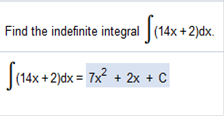
The answer = 7x2 + 2x + c Evaluate 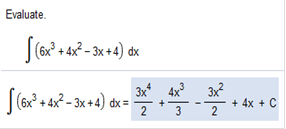
∫ (9x2 − 7x + 5) dx 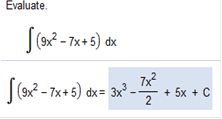
∫ 9x2 = ∫ -7x = ∫ 5 = 5x Solution: 3x3 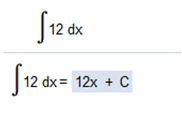
Apply the constant rule…. ∫ (6√x + √2)dx 
Rewrite as 6 ∫ √x + √2 + C We can convert √x as x1/2 the integral of x1/2 is the integral of √2 is √2 so, we have 6 ∫ 6 ∫ The answer is 4x3/2 + √2x + C 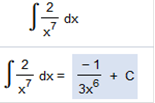
We rewrite as 2 ∫ We can rewrite Now the power rule Now we have 2 ∫ Now we move x-6 to the denominator, and it is positive Find the cost function if the marginal cost function is C’(x) = 3x – 5 and the fixed cost is $11. Find the integral of 3x – 5 (be sure to move the x over next to the fraction) Then add 11 
3x = 3/2x2 -5 = 5x Fixed cost = 11 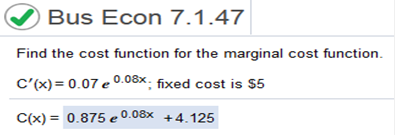
To evaluate remove all values and evaluate as below. .07 / 1(1/08) = .07/.08 = .875 Subtract 5 - .875 = 4.125 Now set up the equation by putting the values back in place. 0.875 e0.08x + 4.125 Find the cost function for the marginal cost function. C’(x) = 7x – 5/x; 10 units cost 279.54 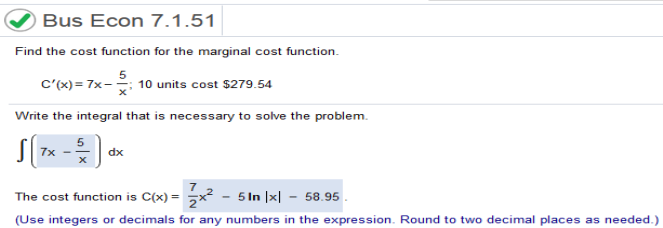
Find the integral of 7x – 5/x = 7/2x2 – 5ln (|x|) (plug in the units (10)) 7/2(10)2 – 5 ln (|(10)|) = 338.48707453503 (is negative) + 279.54 = -58.9471 = round to 2 decimals 58.95 Set up the equation by using the integral 7/2x2 – 5 ln (|x|) - 58.95 Find the demand function for the marginal revenue function. Recall that if no items are sold, the revenue is 0. R’(x) = 0.03x2 – 0.04x + 195 
Find the integral of 0.03x2 – 0.04x + 195 then divide by x (subtract 1 exponent from the top) .01x3 - .02x2 = 195x / x 
Find the integral 0f 7.2t – 16.2 = 3.62 -16t plug in t = 3 3.6(3)2 – 16(3) = -16.2 + -9.4 = positive value 25.6 Combine with integral. 3.6t2 – 16.2t + 25.6 The number of bachelor's degrees conferred has been increasing steadily in recent decades. The rate of change of the number of bachelor's degrees (in thousands) can be approximated by the following function where t is the number of years since 1970. B’ (t) = 0.0612t2 – 1.968t + 1516 
a. Find the integral of Simplify b. plug in 40 and 3 zeros 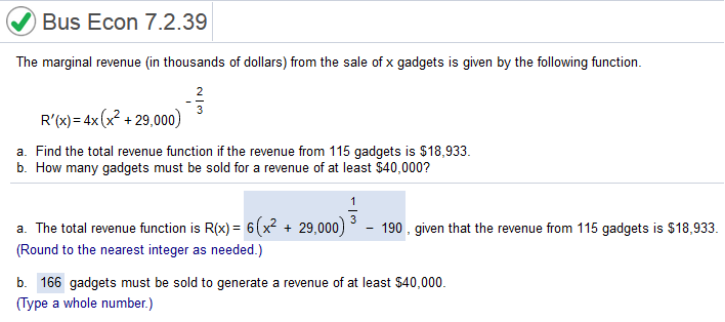
find the integral… 6(x2 + 29000)1/3 Then divide the given gadgets by 1000 = 18.933 and subtract the integral 18.933 – 6(x2 + 29000)1/3 Plug in the 115 value in and solve. 18.933 – 6(1152 + 29000)1/3 = -190 Then subtract from the equation 6(x2 + 29000)1/3 -190 Divide the revenue of 40,000 by a thousand = 40 Solve 6(x2 + 29000)1/3 – 40 for x. Round up to the next whole dollar. An epidemic is growing in a region according to the rate. a. Find the formula for the number of people infected after t days, given that 64 people were infected after t days. b. Use the answer from part a to find the number of people infected after 26 days. 
a. Find the integral. Plug in 0 for t and subtract it from 64 then Use the integral and add the results. b. plug in 26 for t into the equation and solve. C. A definite integral, after evaluating it at the limits of integration, results in a particular number. An indefinite integral results in a set of functions that share the same derivative and uses an arbitrary constant of integration. 
a)) 8(2) + 4(.5) + 8(2.5) + 4(.5) + 8(3) + 4(.5) + 8(3.5) + 4(.5) = 52 b)) 8(2.5) + 4(.5) + 8(3) + 4(.5) + 8(3.5) + 4(.5) + 8(4) + 4(.5) = 60 c)) 52 + 60 / 2 = 56 d)) Midpoint is 2 + 2.5 / 2 = 2.25 8(2.25) + 4(.5) + 8(2.75) + 4(.5) + 8(3.25) + 4(.5) + 8(3.75) + 4(.5) = 56 Check https://www.emathhelp.net/calculators/calculus-2/riemann-sum-calculator/ use left and right endpoints from the dropdown menu f(x) = -x2 + 4 from x = -2 to x = 2 
https://www.emathhelp.net/calculators/calculus-2/riemann-sum-calculator/ a)) -(-2)2 + 4 (1) + -(-1)2 + 4 (1) + -(0)2 + 4(1) + -(1)2 + 4(1) = 10 b)) -(-1)2 + 4 (1) + -(0)2 + 4(1) + -(1)2 + 4(1) –(2)2 + 4 = 10 c)) 10 + 10 / 2 = 10 d)) -(-1.5)2 + 4 (1) + -(-.5)2 + 4(1) + -(.5)2 + 4(1) –(1.5)2 + 4 = 11 f(x) = ex + 3 from x = -2 to x = 2 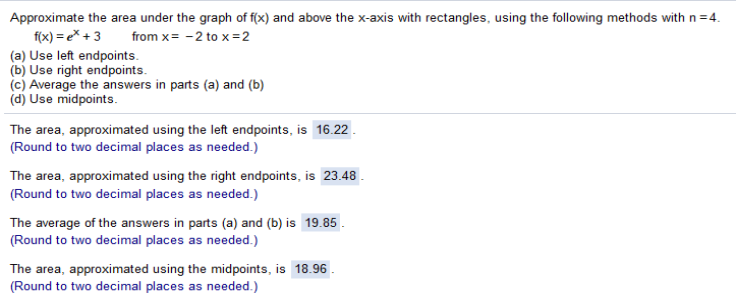
a)) e-2 + 3 (1) + e-1 + 3 (1) + e0 + 3 (1) + e1 + 3 (1) = 16.22 b)) e-1 + 3 (1) + e0 + 3 (1) + e1 + 3 (1) + e2 + 3 (1) = 23.48 c)) 16.22 + 23.48 / 2 = 19.85 b)) e-1.5 + 3 (1) + e-.5 + 3 (1) + e.5 + 3 (1) + e1.5 + 3 (1) = 18.96 
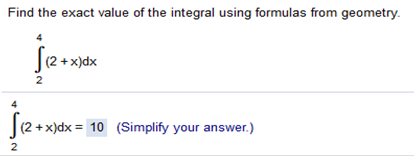
Upper Limit b = 4 Lower limit a = 2 We need to plug in the limits, and then subtract b - a 16 + 8 – 0.5(2) – 2(2) 
9(1) + 5.5(1) + 5(1) = 19.5 5.5(1) + 5(1) + 3.5(1) = 14 What is the marginal cost? Click here to watch the video. Choose the correct description(s) of marginal cost. Select all that apply. B. The derivative of the cost function C. The cost per item What would the marginal cost at 100 units tell you? Click here to watch the video. Choose the correct description of the marginal cost at 100 units. The cost of the 101st phone 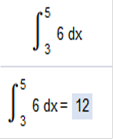
Apply the constant rule. 6x]5,3 Evaluate 6x at 5 and at 3. (6 x 5) – 6 x 3 30 − (6 x 3) = 12 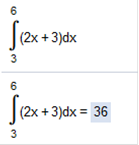
First we find the antidiverative Upper Limit b = 6 Lower limit a = 3 We need to plug in the limits, and then subtract b - a 36 + 18 – 9 + - 9 36 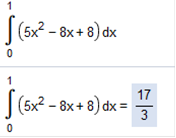
First we find the antidiverative which is So we have We have a fraction, so we will find a common denominator first. (which is 3) NOW, the easiest way to do this is move the variables and exponents to the top. Then we plug in the upper limit. Since the lower limit is zero (0), we do not need to do anything with that, because it will factor to zero(0). It cancels out! So now we have 5(1)3 = 5 12(1)2 = 12 24(1) = 24 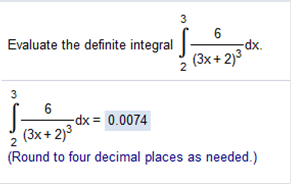
The antidevirative = - Now we plug in the value of the upper limit (3) - Now we plug in the value of the lower limit (2) - Then we subtract −0.00826446 - −0.015625 = 0.00736054 (0.0074) 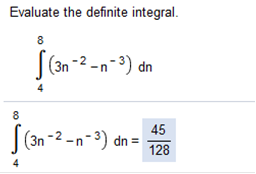
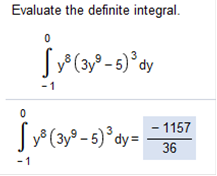
Let x1 be the midpoint of the with subinterval. Complete parts a. and b. below 
a)) Approximate the area of the region using thirteen rectangles. Use the midpoints of each subinterval for the heights of the rectangles. https://www.emathhelp.net/calculators/calculus-2/riemann-sum-calculator/ function: 13 – x lower limit: 0 upper limit 13 Number of rectangles: 13 Type: Midpoint Rule b)) Find Integral. Find the area of the shaded region. 
Solve 121 – x2 = 0,x x = 11, y = 0 so the two subintervals are x = 11, y = 12 integrals f 11,0 (121 – x2) + f 11,12 (121 – x2) 2662 / 3 + 34 / 3 = 2696 / 3 where x varies from 0 to 9 decades. The population of a given age group can be found by integrating this function over the interval for that age group. f(x) = 40.6 + 2.08 – 0.84x2 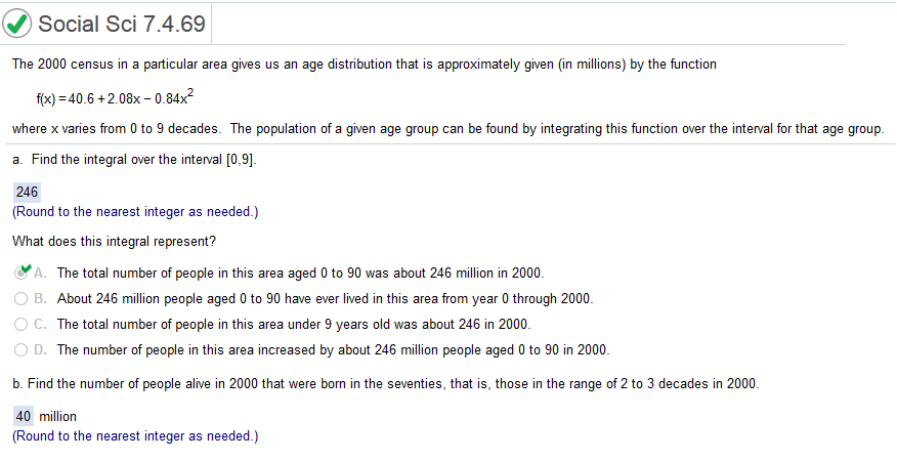
What does this integral represent? The total number of people in this area aged 0 to 90 was about 246 million in 2000. f(x) = x2 – 6; [0,7] 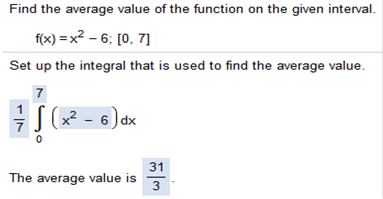
b = 7, a = 0 1 / b - a f b,a (x2 - 6) 1 / 7 – 0 = 1/7 f 7,0 (x2 – 6) 1/7 f 7,0 (x2 – 6) = 31/3 f(x) = x2 – 5; [0,6] 
We need to solve this integral. 
1/5 f 5,0 (√x + 5) 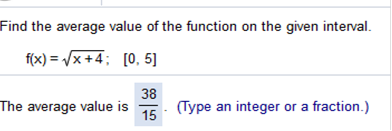
We need to solve the integral below 
Find the average value of the function on the given interval. f(x) = ex/8; [4, 5] 
We need to solve the below integral in decimal Form A stock analyst plots the price per share of a certain common stock as a function of time and finds that it can be approximated by the function S(t) = 50 + 14 e-0.07t, where t is the time (in years) since the stock was purchased. Find the average price of the stock over the first five years. 
1 / b-a f b, a (equation) 1 / 5 – 0 = 1/5 1/5 f 5, 0 (50 + 14 e-0.07t) dt = 61.81 Homework Chapter 1A 1B 2A 2B 3A 3B 4A 4B 5A 6A Chapter Tests 1 2 3 4 5 6 7 FINAL EXAM | Need A Tutor? | Need Homework Help?
|
| Home |
Accounting & Finance | Business |
Computer Science | General Studies | Math | Sciences |
Civics Exam |
Everything
Else |
Help & Support |
Join/Cancel |
Contact Us |
Login / Log Out |